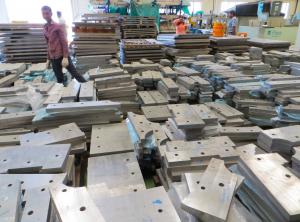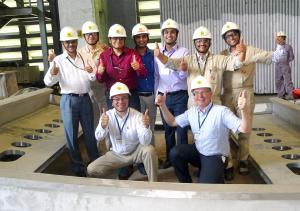In India, "a demonstration of excellence"
For an ITER vacuum expert travelling to India, a collection of in-wall shielding blocks, a cryostat pedestal ring or the full-scale mockup of a cryoline section can more than match in awe and excitement the Taj Mahal, the Khajuraho Temples or the Jaipur Palace.
Like ordinary visitors, vacuum experts try to pack as many destinations as possible into their schedule. Why not take advantage of the start of manufacturing on a vacuum sealing test rig in Bangalore to visit other factories manufacturing ITER's vacuum-related components? Or once in Mumbai, why not take the local train and auto rickshaw to visit the Larsen & Toubro Ltd factory in Hazira, less than half an hour away, before continuing further north to Gandhinagar to work with colleagues at the Institute of Plasma Research?
The trip that ITER Vacuum Section Leader Robert Pearce and vacuum mechanical engineer Eamonn Quinn took to India a few weeks ago was of course not about tourism. As India is involved with many of the industrial components that have vacuum requirements or implications it was important, in Robert's words, "to see for ourselves how our standards are applied and to help to improve efficiency in manufacturing."
At Avasarala Technologies Ltd, where in-wall shielding blocks have entered production; at Larsen & Toubro Ltd, where vacuum leak tests are being performed on kilometre-long lengths of cryostat welds; and in other factories and labs, "the demonstration of engineering excellence was truly refreshing to see," says Eamonn.
The initial reason for travelling to India was the port plug sealing test rig, which is expected to be built at Vacuum Techniques (P) Ltd—one of India's largest and most experienced suppliers of high vacuum equipment.
In the ITER Tokamak, some 30 port plugs will provide the interface between the vacuum vessel and systems such as heating and diagnostics. They are large (2 x 2.5 metres), heavy (45 tons), and the quality of the sealing is critical to maintaining high vacuum inside the plasma chamber. "No one has ever done rectangular metallic demountable sealing of the size required by the ITER port plugs," explains Robert.
After two days of discussion the team headed to Avasarala Technologies Ltd, where an impressive view awaited them: thousands upon thousands of in-wall shielding plates. Made of a sandwich of borated steel blocks, the plates will be fitted between the inner and outer walls of the vacuum vessel to provide radiation protection for the magnets.
The blocks also have a role to play during leak testing of the vacuum vessel, when the interspace will be placed under vacuum. "The blocks need to be perfectly clean and perfectly bolted together so that no gas can be trapped between them," explains the team. The cleanliness and the venting arrangements at the factory proved to be top standard and the vacuum requirements are closely checked by the Indian Domestic Agency, which has a representative on site on a permanent basis.
A short flight to Mumbai and a three-hour train ride later, the pair of vacuum experts was in Hazira, 1,300 kilometres to the north, where Larsen & Toubro Ltd is manufacturing the 54 segments of the ITER cryostat—the giant thermos that ensures the thermal insulation of the superconducting magnets.
For cryostat manufacturing, the strict observance of vacuum requirements—especially in relation to the welds—is paramount. Using the "hood technique" (leak-tight vacuum cups of 15 different sizes and shapes that are affixed to the weld) and mass spectrometry, Larsen & Toubro has successfully tested 15 percent of the welds made at the factory (665 m out of 4,500 km). Robert and Eamonn also witnessed progress in the manufacturing of the pedestal ring and the lower cylinder of the cryostat, where ITER's cryopumps will be located.
There was one last stop, many hours to the north by train, before heading back to ITER—Gandhinagar, home of the Institute of Plasma Research and the Indian Domestic Agency. Two full days of meetings on many items including the diagnostics neutral beam injector, diagnostic vacuums, and cryogenic supplies were capped off with a lecture on ITER's vacuum system delivered to a packed auditorium.
At the Institute of Plasma Research, the pair of ITER vacuum experts felt at home. "Based on their experience with the SST-1 tokamak, which we got a chance to visit, India really understands the importance of high vacuum standards," says Robert. "And as they are procuring quite a lot of vacuum or vacuum-related items, that's a strong guarantee for the success of ITER."
Upon reflexion, there was a bit of the tourist's experience during this 9-day trip to India—Robert was blessed by being gouged by a sacred cow in Mumbai and both suffered the consequences of being adventurous with the food on their way home ...



